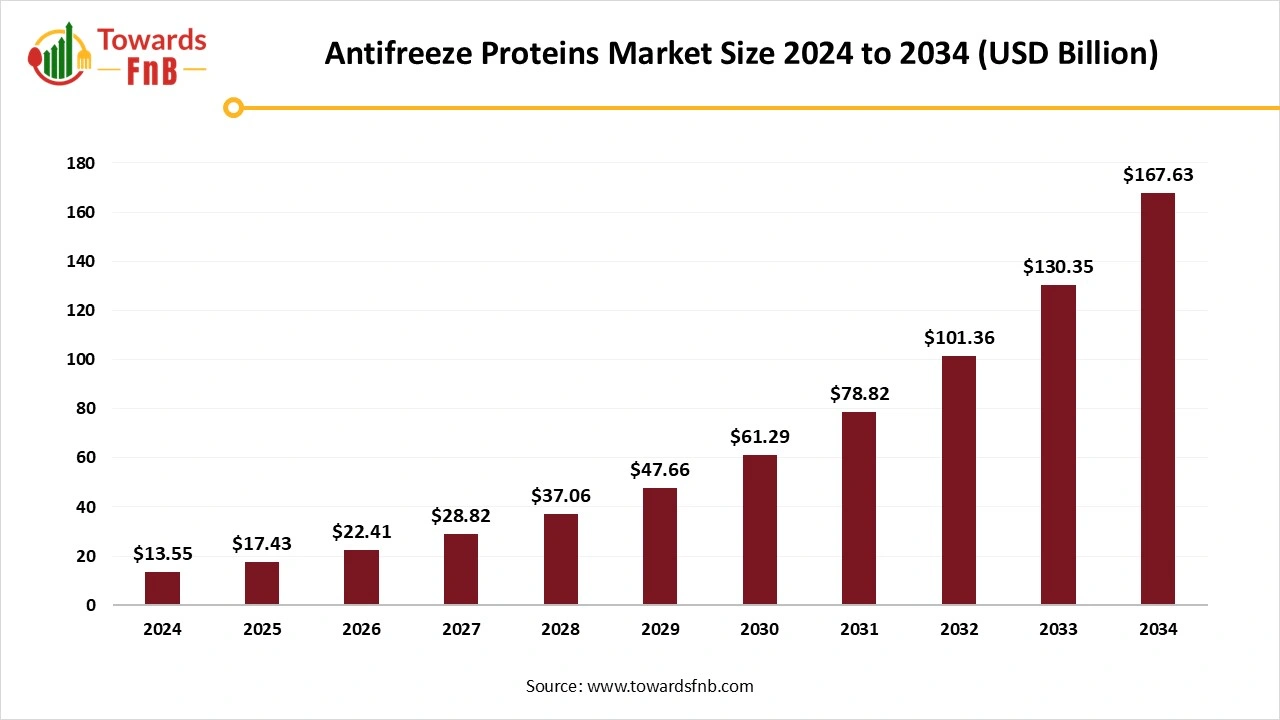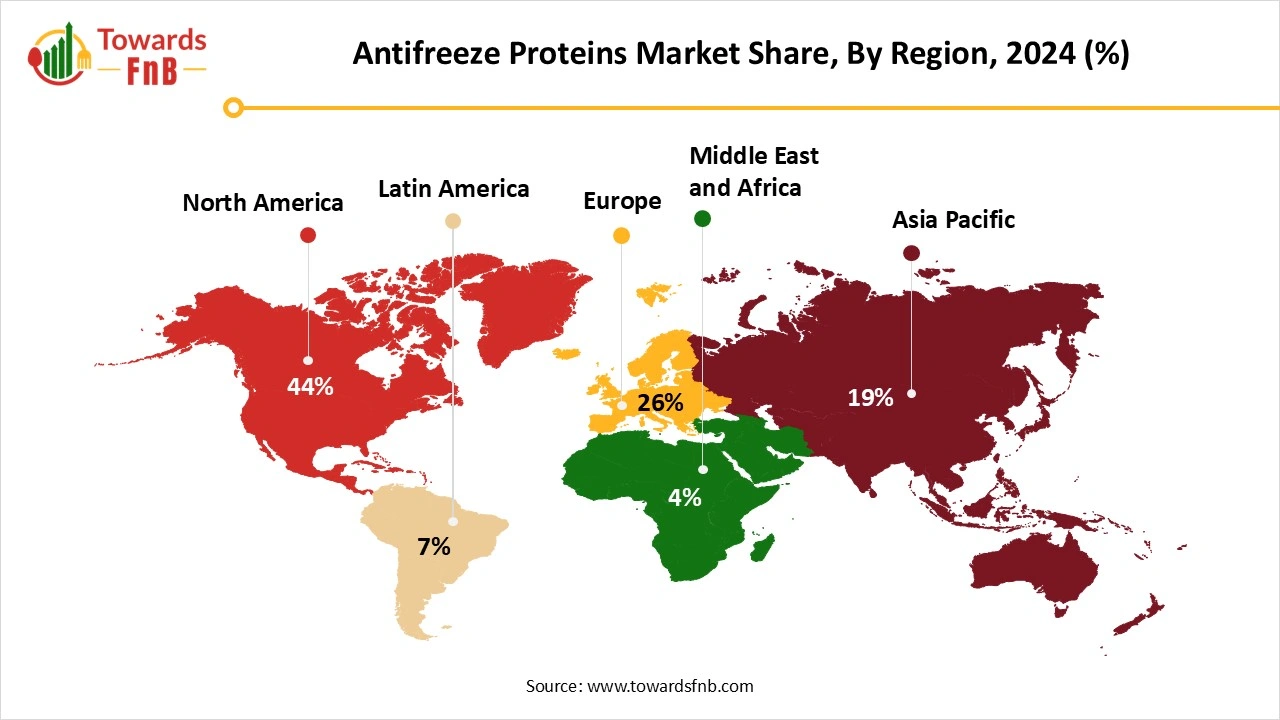November 2025
The global antifreeze proteins market size reached at USD 13.55 billion in 2024 and is anticipated to increase from USD 17.43 billion in 2025 to an estimated USD 167.63 billion by 2034, witnessing a CAGR of 28.6% during the forecast period from 2025 to 2034. The antifreeze proteins market is driven by the increasing demand for medical and pharmaceutical applications, such as cryopreservation of organs, tissues, and cells for cell therapies and transplants.

| Study Coverage | Details |
| Growth Rate from 2025 to 2034 | CAGR of 28.6% |
| Market Size in 2025 | USD 17.43 Billion |
| Market Size in 2026 | USD 22.41 Billion |
| Market Size by 2034 | USD 167.63 Billion |
| Largest Market | North America |
| Base Year | 2024 |
| Forecast Period | 2025 to 2034 |
| Regions Covered | North America, Europe, Asia-Pacific, Latin America, and Middle East & Africa |
Antifreeze proteins (AFPs) are biologically derived proteins and glycoproteins that inhibit ice crystal formation and growth, lowering the freeze-point and reducing freeze-thaw damage in cells, tissues, and products. Sourced from cold-adapted fish, insects, plants or produced recombinantly, AFPs are used in food preservation, cryopreservation, pharmaceuticals, cosmetics, agriculture, and research. They improve frozen-product quality, enable better cold-chain storage for biologics, and reduce cellular damage during freezing driving demand for extraction, recombinant production, and formulation services.
The antifreeze proteins market growth is also driven by factors such as increasing demand for cold chain solutions to ensure product integrity, rising innovations in recombinant DNA technology and genetic engineering, growing food industry, increasing demand for medical and pharmaceutical applications, increasing consumer preference towards bio-based and eco-friendly alternatives, increasing use in organ transplants and cryopreservation and increasing demand in the food sector for quality preservation.
The rise of technological advancements in the antifreeze protein industry includes the use of genetic engineering to produce low-immunogenic, functional versions, computational design to create specific, enhanced AFPs, and recombinant DNA technology to improve production. These innovations make AFPs more effective and accessible across a wide range of applications, including crop protection, food preservation, and medical cryopreservation. Technologies such as recombinant DNA technology are utilized to produce high-quality AFPs with improved properties and make them more accessible for several applications, which is expected to revolutionize the growth of the antifreeze proteins market in the coming years.
Raw Material Procurement
Packaging and Branding
Waste Management and Recycling
Antifreeze Proteins Industry’s Regulatory Landscape: Global Regulations
| Country | Regulatory Body | Key Regulations | Focus Areas | Notable Notes |
| India | Food Safety and Standards Authority of India (FSSAI) | Food Safety and Standards (Packaging and Safety Regulations) and Licensing and Registration of Food Businesses) | The antifreeze proteins market focuses on alternative ingredients and food and beverage industries, enhancing biotechnology and sustainability, and health and wellness. The market also focuses on consumer health, dietary supplements, and functional foods due to their rich nutritional profile. | Antifreeze proteins are widely used in natural and plant-based food ingredients for their capacity to enhance the efficiency, consistency, and quality of high-quality food products, and to support consumers' immune system and health and wellness. |
Why is North America Dominating the Antifreeze Proteins Market?
North America dominated the global market, accounting for 44% of revenue in 2024. The market in the region is experiencing rapid growth, driven by demand for plant-based, clean-label, and sustainable protein ingredients in the food and beverage industry. Major factors include the growing use of alternative ingredients, snacks, and convenience food; the rising demand for frozen foods; and the growing consumer demand for relevant products. The U.S. and Canada are the major drivers of market growth.
The U.S. Antifreeze Proteins Market Trends
The U.S. dominates to global market revenue, with demand driven by the popularity of frozen and processed goods, clean label ingredients, increasing use in cryopreservation in the medical industry, increasing consumer focus on health and wellness, and increasing demand for sustainable and plant-based products such as dairy and bakery alternatives.

Asia Pacific is Expected to Grow Fastest During the Forecast Period.
The global market growth in the region is attributed to the factors such as increasing applications in the food and beverage, increasing awareness of health and environmental benefits, rising technological advancements in protein engineering, increasing consumer demand for plant-based, natural and sustainable ingredients, increasing significant investment in the food industry, increasing demand for alternative protein and increasing demand for dairy alternatives such as cheese, ice cream and milk. China, India, Japan, and South Korea are the fastest-growing countries driving the market growth.
India Antifreeze Proteins Market Trends
India is expected to grow fastest during the forecast period. The global antifreeze proteins industry in India is growing rapidly, driven by increasing demand for dairy alternatives and natural ingredients, supportive government initiatives, expansion of the food and beverages industry, growing consumer demand for sustainable and natural ingredients, and demand for frozen desserts, frozen foods, and ready-to-eat meals.
Europe is Expected to Grow at a Notable Rate During the Forecast Period.
The global antifreeze proteins market is driven by the increasing use of specialty protein products for its nutritional products, increasing growth of the well-developed food and beverage industry, increasing demand for processed and frozen goods, technological advancements in protein engineering applications, increasing food safety regulations, and increasing demand for plant-based and sustainable ingredients. The UK, Germany, and France are the major countries driving the market growth.
Germany Antifreeze Proteins Market Trends
The antifreeze proteins industry in Germany is driven by the increasing demand for plant-based and alternative protein sources, which is driving the fermentation sector. Major growth factors such as the rising technological advances in protein engineering processes, rising high investments in biomedical research, cryobiology, and the cosmetics and food industries.
Latin America Antifreeze Proteins Market Trends
The market growth in the region is driven by the increasing large consumer base, growing rapid urbanization, growing food and beverage, increasing use of protein in alternative ingredients, increasing consumer preference in sustainable food ingredient, expanding food and beverage industry, increasing adoption of animal feed supplement, increasing need for greater regulatory support, and increasing consumer preference for natural and plant-based ingredients. Brazil, Mexico, and Argentina are the major countries driving the market growth.
Mexico Antifreeze Proteins Market Trends
The country's market growth is driven by increasing demand for sustainable and alternative proteins and by expanding food and beverage industries, especially convenience and frozen foods. Other factors such as the growing fermentation applications in food and beverages and growing strong protein engineering processing industry, rising technological advancements in anti-aging and skincare products, and increasing demand for baked goods.
The Middle East and Africa are the Significant Regions in the Market in 2024
The antifreeze proteins market growth in the region is driven by factors such as increasing support from private and government initiatives, increasing investment in efficiency improvements and processing, increasing use of fermentation in various industries, increasing need to improve cold chain logistics for vaccines, increasing disposable incomes, growing food and beverage industry, and rising rapid urbanization. South Africa, UAE, Saudi Arabia, and Kuwait are the major countries driving the market growth.
South Africa Antifreeze Proteins Market Trends
The food and beverage industry is the largest consumer in the country, driven by increasing consumer trends towards sustainability, increasing government policies for protein engineering processes, rising investment in research and development activities, increasing use in protein-based production, and increasing demand for plant-based proteins in food and beverages.
Why are Antifreeze Glycoproteins (AFGPs) Segment Dominating the Antifreeze Proteins Market?
The antifreeze glycoproteins (AFGPs) segment dominated the global market, accounting for 45.9% of revenue in 2024. Antifreeze Glycoproteins (AFGPs) play an important role in the antifreeze proteins industry as they have wide applications in biotechnology, food science, and cryopreservation, and prevent ice crystal growth in organisms. They function by binding to ice crystals, thereby inhibiting the formation of damaging ice crystals and lowering the freezing point of the surrounding fluid. This ability to protect against ice damage makes them invaluable for applications such as protecting crops, enhancing frozen foods like ice cream, and preserving organs and cells.
The Type III AFP Segment is Expected to Grow at the Fastest 13.5% CAGR During the Forecast Period.
Type III antifreeze proteins (AFPs) play a major role because they inhibit ice crystal growth. They also promote cryopreservation and protect cells from cold. Their presence lies in their unique globular structure, which enables them to protect cells from freezing and hypothermic damage, prevent their growth, and bind to ice, making them more significant tools for biotechnological applications, further driving market growth.
The Type I AFP segment is expected to grow at a notable rate during the forecast period. Type I AFPs are major due to their ability to enhance ice crystal growth in cryopreservation and polar fish, where they can protect cells from freezing damage by stabilizing membranes and binding to ice. Their alanine-rich and simple structure makes researchers understand the AFP mechanisms.
Why is the Fish-Derived AFPs Segment Dominating the Antifreeze Proteins Market?
The fish-derived AFPs segment dominated the global market, accounting for 46.8% of revenue in 2024. The segment growth in the global market is driven by various benefits, such as recrystallization of ice crystals, inhibition of growth, lowering the non-colligative freezing point of water, enhancing membrane stabilization, and being effective and non-toxic at low concentrations. Some fish AFPs, such as types 1 and 3, help prevent damage and stabilize them during cold storage.
The Recombinant/Synthetic AFPs Segment is Expected to Grow at a 13.6% CAGR During the Forecast Period.
The segment growth in the antifreeze proteins market is driven by factors such as improving the texture and shelf-life of frozen foods such as fish, meat, dough, and cream, enhancing the cryopreservation of cells, targeted properties, increased activity, customization, enhanced functionality, improved consistency and purity, cost-effectiveness, and scalability.
The plant-derived AFPs segment is expected to grow at a notable rate during the forecast period. Segment growth in the global market is attributed to increasing consumer preference for natural and plant-based alternatives that protect against damage, increased dual functionality, and the growth of ice crystals, as well as accessibility and cost-effectiveness.
How do Food Processors & the Seafood Industry Segment Dominating the Antifreeze Proteins Market?
The food processors and seafood industry segment dominated the antifreeze proteins market, accounting for 46.5% of the market in 2024. Segment growth in the global market is driven by improved product texture and quality, reduced water migration and drip loss, extended shelf life, increasing consumer demand for natural or premium products, advances in biotechnology, rising disposable incomes, and growing urbanization.
The Pharmaceutical & Biotech Companies Segment is Expected to Grow at a 14.2% CAGR During the Forecast Period.
The growth of the segment is driven by factors such as the increasing efficiency of protein-based products, expansion of the functional food and biotechnology industries, increasing consumer awareness towards health and wellness, enhanced ability and scalability to produce highly pure specialty proteins, increasing consumer preference towards health-focused, organic, and natural alternative ingredients, and rising technological advancements in recombinant protein and protein engineering.
The agricultural biotech firm segment is expected to grow at a notable rate during the forecast period. Segment growth in the global market is attributed to increasing research and development activities, the growing food industry, improvements in the shelf life and texture of frozen foods such as desserts and ice cream, the need for sustainable and natural solutions, technological advancements in production, and the rising demand for frost-resistant crops.
By Type
By Source
By End-User
By Region
November 2025
November 2025
November 2025
November 2025